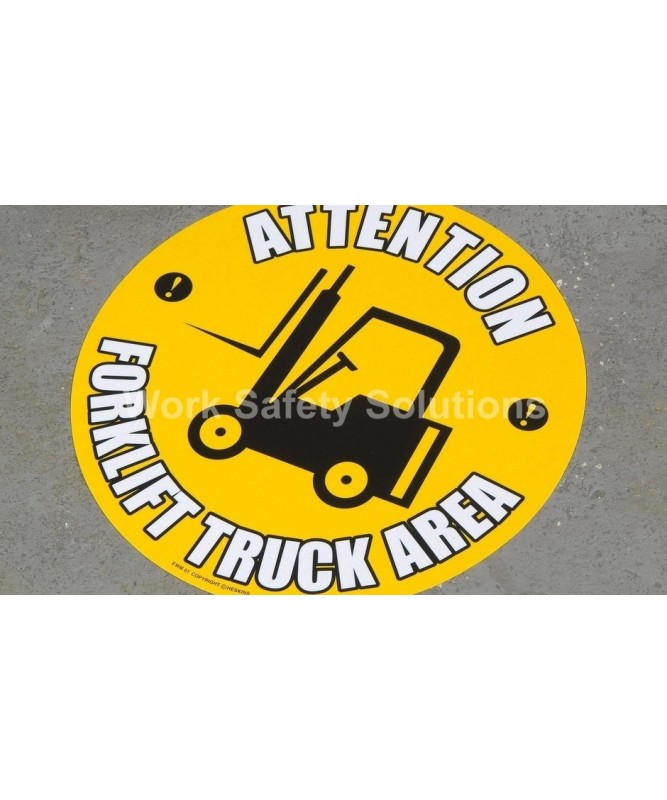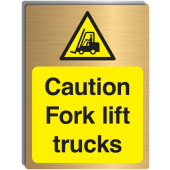Forklift Truck Safety Signs-- Safeguard Your Team with Reliable Safety Markings
Forklift Truck Safety Signs-- Safeguard Your Team with Reliable Safety Markings
Blog Article
Key Factors To Consider for Creating Effective Forklift Safety Indicators
When designing effective forklift safety indications, it is crucial to think about numerous essential factors that collectively make certain optimal visibility and clearness. High-contrast colors coupled with big, understandable sans-serif fonts considerably improve readability, specifically in high-traffic areas where quick comprehension is crucial. forklift signs. Strategic positioning at eye degree and using durable materials like aluminum or polycarbonate further add to the durability and effectiveness of these indicators. In addition, adherence to OSHA and ANSI standards not just systematizes safety and security messages however likewise boosts conformity. To fully comprehend the ins and outs and finest techniques involved, numerous added factors to consider merit closer attention.
Color and Contrast
While creating forklift safety indications, the selection of color and comparison is extremely important to making certain exposure and performance. The Occupational Security and Health Management (OSHA) and the American National Standards Institute (ANSI) offer standards for using colors in safety and security signs to standardize their definitions.
Effective comparison between the history and the message or signs on the indicator is similarly vital. High contrast makes sure that the indicator is understandable from a distance and in differing illumination conditions. For instance, black text on a yellow background or white text on a red history are combinations that stick out prominently. Additionally, the use of reflective products can enhance visibility in low-light atmospheres, which is typically a consideration in storehouse setups where forklifts operate.
Using proper color and contrast not just sticks to regulative criteria yet also plays an important function in maintaining a risk-free working setting by ensuring clear communication of threats and directions.

Typeface Size and Design
When creating forklift safety indications, the selection of font size and design is crucial for making certain that the messages are readable and quickly recognized. The main objective is to improve readability, especially in environments where quick details handling is crucial. The font dimension need to be big sufficient to be read from a range, accommodating varying view problems and guaranteeing that workers can comprehend the indication without unneeded strain.
A sans-serif font is normally recommended for safety and security indicators due to its clean and simple look, which boosts readability. Fonts such as Arial, Helvetica, or Verdana are usually liked as they do not have the intricate details that can obscure important info. Uniformity in font style across all safety indications help in producing an attire and expert appearance, which additionally enhances the importance of the messages being conveyed.
Furthermore, focus can be achieved through strategic use of bolding and capitalization. Keyword or phrases can be highlighted to draw prompt focus to essential instructions or warnings. Overuse of these techniques can result in visual clutter, so it is vital to use them deliberately. By meticulously picking proper font style sizes and styles, forklift security indications can efficiently communicate essential safety details to all employees.
Placement and Presence
Making sure optimal placement and presence of forklift security signs is extremely important in industrial setups. Appropriate sign positioning can dramatically decrease the threat of mishaps and enhance general office safety and security. Signs must be placed at eye level to guarantee they are easily visible by operators and pedestrians. This commonly implies positioning them between 4 and 6 feet from the ground, depending upon the average height of the workforce.

Indicators should be well-lit or made from reflective products in poorly lit areas to guarantee they are noticeable at all times. By carefully taking into consideration these aspects, one can make sure that forklift safety and security signs are both efficient and noticeable, thus promoting a more secure working environment.
Material and Durability
Selecting the ideal materials for forklift safety indications is essential to ensuring their durability and performance in commercial settings. Given the rough problems frequently come across in stockrooms and manufacturing facilities, the materials picked need to hold up against a variety of stress factors, including temperature changes, wetness, chemical direct exposure, and physical effects. Long lasting substratums such as light weight aluminum, high-density polyethylene (HDPE), and polycarbonate are preferred selections as a result of their resistance to these components.
Aluminum is renowned for its toughness and rust resistance, making it a superb selection for both indoor and outside applications. HDPE, on the other hand, provides remarkable influence resistance and can withstand extended exposure to severe chemicals without breaking down. Polycarbonate, understood for its high effect strength and clarity, is commonly utilized where exposure and sturdiness are paramount.
Equally essential is the kind of printing utilized on the signs. UV-resistant inks and safety finishings can significantly boost the lifespan of the signs by avoiding fading and wear triggered by long term exposure to sunlight and various other environmental elements. Laminated or screen-printed surfaces supply additional layers of security, making sure that forklift signs the essential security details remains understandable in time.
Buying premium products and durable production processes not just extends the life of forklift safety indicators yet also strengthens a society of safety and security within the work environment.
Conformity With Laws
Following regulatory criteria is vital in the style and release of forklift safety and security indicators. Compliance makes sure that the indications are not just reliable in sharing critical safety and security information but likewise satisfy lawful commitments, thereby reducing prospective obligations. Numerous companies, such as the Occupational Safety And Security and Health Administration (OSHA) in the United States, offer clear guidelines on the specifications of security indicators, consisting of color design, message dimension, and the incorporation of globally recognized symbols.
To conform with these laws, it is vital to conduct an extensive evaluation of suitable requirements. For circumstances, OSHA mandates that security indicators have to be noticeable from a range and consist of certain colors: red for danger, yellow for caution, and green for security directions. Additionally, sticking to the American National Specification Institute (ANSI) Z535 series can further improve the efficiency of the signs by standardizing the layout aspects.
Furthermore, normal audits and updates of safety and security signs need to be done to guarantee ongoing conformity with any adjustments in guidelines. Engaging with certified safety specialists during the design stage can also be valuable in making sure that all regulatory needs are fulfilled, and that the indicators serve their desired purpose properly.
Final Thought
Designing efficient forklift security signs needs cautious focus to shade contrast, font size, and style to make sure optimum exposure and readability. Adherence to OSHA and ANSI standards systematizes safety messages, and incorporating reflective materials enhances exposure in low-light scenarios.
Report this page